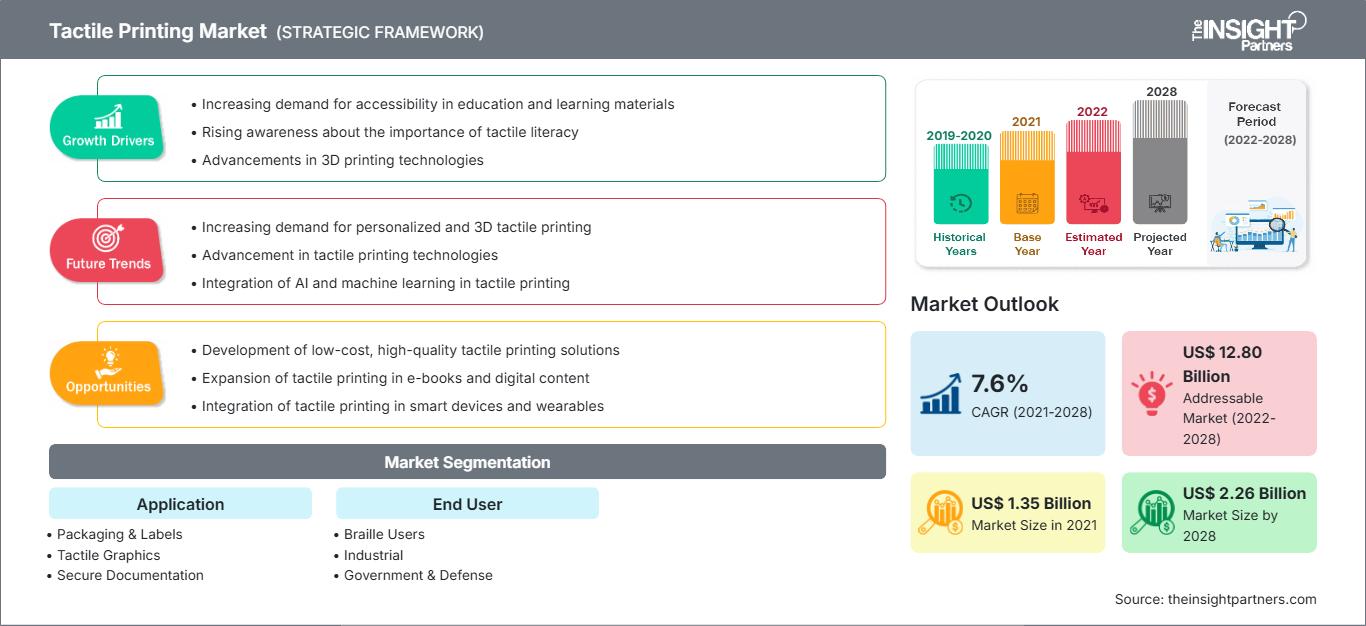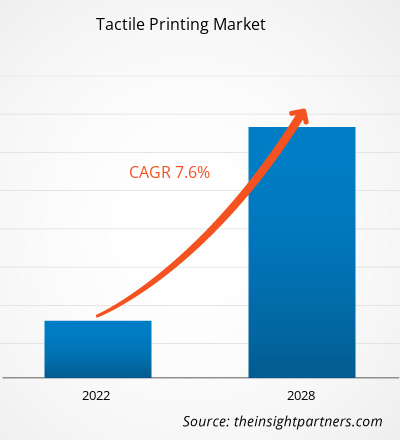Der Markt für taktilen Druck wurde im Jahr 2021 auf 1.353,27 Millionen US-Dollar geschätzt und soll bis 2028 voraussichtlich 2.257,92 Millionen US-Dollar erreichen; von 2021 bis 2028 wird ein durchschnittliches jährliches Wachstum von 7,6 % erwartet.
Beim taktilen Druck wird auf einem Drucksubstrat eine Textur erzeugt, die durch Berührung wahrgenommen werden kann. Taktiler Druck findet vielfältige Anwendung in der Pharmazie, bei medizinischen Verpackungen, im Sozialwesen, in den Gesundheitswissenschaften, in der Landwirtschaft, im Dienstleistungssektor und in anderen Sektoren. Die Nachfrage nach taktilem Druck wird hauptsächlich durch den zunehmenden Einsatz dieser Technik in den Bereichen Kartierung, Etikettierung, Verpackung, Sicherheit und sichere Dokumentation getrieben. Steigende Investitionen in die Braille-Drucktechnologie aufgrund der steigenden Nachfrage nach kundenspezifischen Lösungen wie Spielen, Armbändern, Musikkarten, Pins, Schaltern, Visitenkarten, Ortsschildern, Aufklebern, Grußkarten und Taschenrechnern in Brailleschrift fördern das Wachstum des Marktes für taktile Drucke. Da viele Länder die Beschäftigung von Sehbehinderten fördern, bietet die Braille-Druckindustrie den Akteuren des Marktes für taktile Drucke erhebliche Chancen.
Passen Sie diesen Bericht Ihren Anforderungen an
Sie erhalten kostenlos Anpassungen an jedem Bericht, einschließlich Teilen dieses Berichts oder einer Analyse auf Länderebene, eines Excel-Datenpakets sowie tolle Angebote und Rabatte für Start-ups und Universitäten.
Markt für taktilen Druck: Strategische Einblicke

-
Holen Sie sich die wichtigsten Markttrends aus diesem Bericht.Dieses KOSTENLOSE Beispiel umfasst Datenanalysen, die von Markttrends bis hin zu Schätzungen und Prognosen reichen.
Aufgrund der Störungen von Angebot und Nachfrage entlang der gesamten Wertschöpfungskette verzeichnen Unternehmen, die auf dem globalen Markt für taktilen Druck tätig sind, einen Rückgang ihrer Einnahmen und ihres Geschäftswachstums. Daher hat der Ausbruch das Gesamtwachstum des Marktes im Jahr 2020 in gewissem Maße gebremst. Aufgrund des erwarteten Anstiegs der Nachfrage von gewerblichen und industriellen Nutzern weltweit wird jedoch erwartet, dass sich das Marktwachstum ab dem dritten Quartal 2021 normalisiert und von 2021 bis 2028 stetig weiter wächst.
Markteinblicke in den taktilen Druck: Wachsende Nachfrage nach taktilen Grafiken zur Unterstützung sehbehinderter Menschen
Arbeitgeber in kleinen und mittleren Unternehmen bieten einem vielfältigen Spektrum an Bewerbern Beschäftigungsmöglichkeiten und berücksichtigen auch körperlich behinderte Bewerber in der Belegschaft. Infolgedessen beschäftigen Sektoren wie Marketing, Unternehmensführung und -verwaltung, Humandienstleistungen, Gesundheitswissenschaften und Landwirtschaft in großem Umfang sehbehinderte Bewerber. Zu den weiteren Branchen, in denen sehbehinderte Menschen beschäftigt sind, gehören gemeinnützige Organisationen, lokale, staatliche und bundesstaatliche Behörden sowie selbstständige Unternehmer. Gesetzesänderungen und Bürgerrechtsgesetze wirken sich ebenfalls positiv auf die Karrierechancen sehbehinderter Menschen aus. Daher besteht eine hohe Nachfrage nach taktilen Beschilderungen und Karten, um diese Menschen am Arbeitsplatz zu unterstützen.
Anwendungsbasierte Markteinblicke
Basierend auf der Anwendung ist der Markt für taktilen Druck in Verpackungen und Etiketten, taktile Grafiken und sichere Dokumentation unterteilt. Das Segment Verpackungen und Etiketten war 2020 marktführend. Taktiler Druck findet eine wichtige Anwendung in Verpackungs- und Etikettiervorgängen in verschiedenen Branchen, was Unternehmen dabei hilft, eine breitere Kundenbasis zu erreichen. Taktil bedruckte Verpackungsmaterialien und Etiketten helfen auch sehbehinderten Menschen. Darüber hinaus verhilft der Einsatz von taktilem Druck den Marken zu einer trendigen Präsentation und dekorativen Verzierung von Verpackungen, indem er Barriere- und andere besondere Merkmale bietet.
Die Akteure auf dem Markt für
taktilen Druck
verfolgen Strategien wie Fusionen, Übernahmen und Marktinitiativen, um ihre Position auf dem Markt zu behaupten. Im Folgenden sind einige Entwicklungen der wichtigsten Akteure aufgeführt:- Im Jahr 2020 führte ViewPlus Technologies Inc. den stärksten und am besten lesbaren Braille-Punkt aller Desktop-Braille-Drucker ein und behielt mit dem jetzt verfügbaren Power-Dot Braille gleichzeitig eine ansprechende abgerundete Punktform bei. Der VP Delta 2 und der VP Columbia 2 prägen weiterhin hochauflösende taktile Grafiken und Braille der Library of Congress (LOC).
- Im Jahr 2021 kündigte die Roland DGA Corporation die Einführung von VersaUV LEC2-640 und LEC2-330 an, UV-Drucker/Schneideplotter der nächsten Generation, die speziell dafür entwickelt wurden, die Produktion von Etiketten, Verpackungen, Schildern, Displays und Innendekorationen auf ein neues Niveau zu heben.
Markt für taktilen Druck
Die Analysten von The Insight Partners haben die regionalen Trends und Faktoren, die den Markt für taktile Drucke im Prognosezeitraum beeinflussen, ausführlich erläutert. In diesem Abschnitt werden auch die Marktsegmente und die geografische Lage in Nordamerika, Europa, dem asiatisch-pazifischen Raum, dem Nahen Osten und Afrika sowie Süd- und Mittelamerika erörtert.Umfang des Marktberichts zum taktilen Druck
| Berichtsattribut | Einzelheiten |
|---|---|
| Marktgröße in 2021 | US$ 1.35 Billion |
| Marktgröße nach 2028 | US$ 2.26 Billion |
| Globale CAGR (2021 - 2028) | 7.6% |
| Historische Daten | 2019-2020 |
| Prognosezeitraum | 2022-2028 |
| Abgedeckte Segmente |
By Anwendung
|
| Abgedeckte Regionen und Länder |
Nordamerika
|
| Marktführer und wichtige Unternehmensprofile |
|
Dichte der Marktteilnehmer im taktilen Druck: Verständnis ihrer Auswirkungen auf die Geschäftsdynamik
Der Markt für taktile Drucke wächst rasant. Die steigende Nachfrage der Endverbraucher ist auf Faktoren wie veränderte Verbraucherpräferenzen, technologische Fortschritte und ein stärkeres Bewusstsein für die Produktvorteile zurückzuführen. Mit der steigenden Nachfrage erweitern Unternehmen ihr Angebot, entwickeln Innovationen, um den Bedürfnissen der Verbraucher gerecht zu werden, und nutzen neue Trends, was das Marktwachstum weiter ankurbelt.

- Holen Sie sich die Markt für taktilen Druck Übersicht der wichtigsten Akteure
- Verpackungen und Etiketten
- Taktile Grafiken
- Sichere Dokumentation
Markt für taktilen Druck – nach Endbenutzer
- Braille-Benutzer
- Industrie
- Regierung und Verteidigung
Markt für taktilen Druck – nach Geographie
-
Nordamerika
- USA
- Kanada
- Mexiko
-
Europa
- Deutschland
- Frankreich
- Italien
- Vereinigtes Königreich
- Russland
- Übriges Europa
-
Asien Pazifik (APAC)
- Australien
- China
- Indien
- Japan
- Südkorea
- Rest von APAC
-
Naher Osten und Afrika (MEA)
- Südafrika
- Saudi-Arabien
- VAE
- Rest von MEA
-
Südamerika (SAM)
- Brasilien
- Argentinien
- Rest von SAM
Unternehmensprofile
- Altix
- Konica Minolta, Inc.
- Rink Printing Company
- Sturdy Print & Design Ltd
- American Thermoform
- Canon Inc
- Index Braille
- Kanematsu USA
- ViewPlus Technologies Inc
- Roland DG Corporation
- Historische Analyse (2 Jahre), Basisjahr, Prognose (7 Jahre) mit CAGR
- PEST- und SWOT-Analyse
- Marktgröße Wert/Volumen – Global, Regional, Land
- Branchen- und Wettbewerbslandschaft
- Excel-Datensatz
Aktuelle Berichte
Verwandte Berichte
Erfahrungsberichte
Grund zum Kauf
- Fundierte Entscheidungsfindung
- Marktdynamik verstehen
- Wettbewerbsanalyse
- Kundeneinblicke
- Marktprognosen
- Risikominimierung
- Strategische Planung
- Investitionsbegründung
- Identifizierung neuer Märkte
- Verbesserung von Marketingstrategien
- Steigerung der Betriebseffizienz
- Anpassung an regulatorische Trends






















 Kostenlose Probe anfordern für - Markt für taktilen Druck
Kostenlose Probe anfordern für - Markt für taktilen Druck